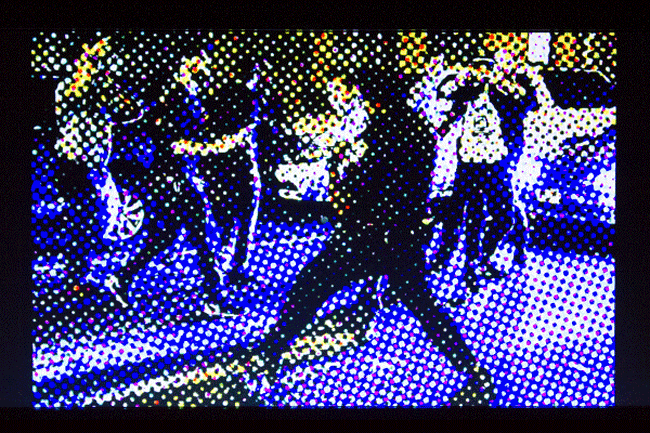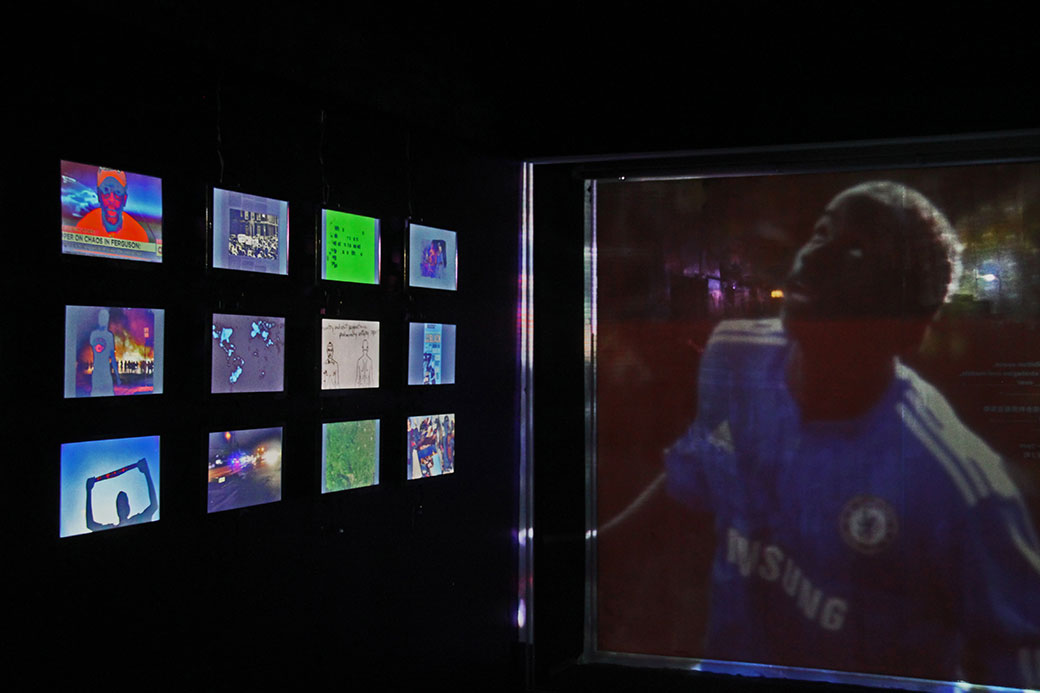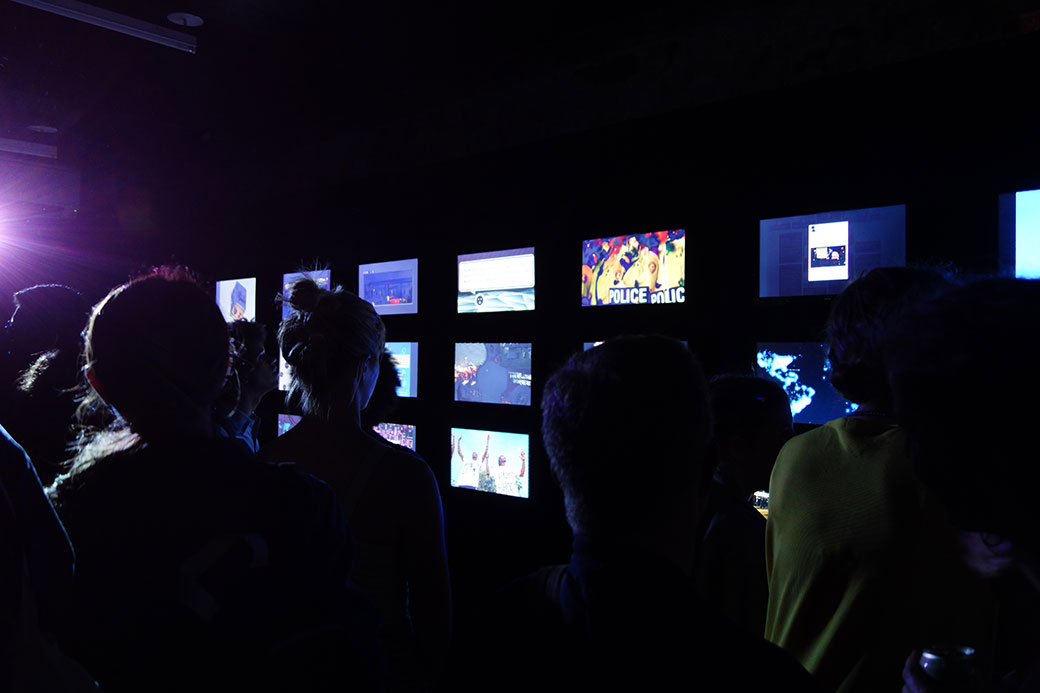Editor’s Note: On November 24, 2014, St. Louis County prosecutor Robert McCulloch announced the grand jury’s decision not to indict Ferguson police officer Darren Wilson (who recently resigned) in the shooting death of Michael Brown. At the time of this writing, the grand jury’s decision was still pending.

HowDoYouSayYamInAfrican? From the Post-Speculation, Act 1 exhibition at P! Gallery, September 2014. GIF: Rhett Jones/ANIMALNewYork.
The collective HowDoYouSayYamInAfrican?, otherwise known as the Yams, characterizes a new generation of revolutionary artists and thinkers who refuse to participate in the prescriptions of the marketplace and traditional authority. Instead they create radical, new methods of engagement. The Yams’ members—thirty-eight self-described Black and queer artists, poets, and scholars—employ a methodology directed toward creating a strong voice for the Black community amid a history of racism and inequality. For one Yams member, Dawn Lundy Martin, “a movement towards Afrofuturism” is of primary importance.1
According to the Yams artist Christa Bell, the collective’s response to “institutional white supremacy” led to the withdrawal of their movie Good Stock for Dimension: An Opera (2014) from the 2014 Whitney Biennial on the grounds of compromised identity and inequitable representation of the African diaspora. The withdrawn film is a precursor to the group’s strident twenty-four-screen video installation, The Wayblack Machine (2014). While multiple vignettes in Good Stock for Dimension: An Opera combine song, dance, and music to focus on the recognition of blackness, and a vision toward a larger utopian agenda, The Wayblack Machine takes a more forceful form of activism. Presented from the point of view of communal and public citizenship, the shooting death of Michael Brown (a young, Black, unarmed man) by Darren Wilson (a white police officer) in Ferguson, Missouri, takes center stage in this video installation.

HowDoYouSayYamInAfrican? The Wayblack Machine, 2014. Twenty-four-channel video installation plus double projection and sculptural works; dimensions variable. Installation view: Post-Speculation, Act I at P! Gallery, September 2014. Courtesy the artists.
Constructed from material primarily collected from social media outlets, hashtag trends on Twitter and Instagram, press footage, and extensive statistical data drawn from research on race and discrimination, the fast-moving simultaneous videos unravel different combinations of images: Brown’s prone body, protest marches, police attacks, interviews, arrests, numbers, and slogans that captured racial tensions between the mostly black community and the mostly white city government and police officers. Sounds of sirens, chaos, and violence are interspersed with hashtag-derived responses of hatred and solidarity. Images of military personnel during the ensuing riots are similar to those of the Egyptian army during the 2011 revolution (a resemblance that has led activists in the Middle East to express support to the citizens of Ferguson).
By using material from the Internet and diverse public responses to the incendiary situation in Ferguson, the Yams employ these new tools to recontextualize the legacy of violence and discrimination. While discussing The Wayblack Machine Martin spoke on the notion of speculation as the “creation of a marginal space of inquiry” and of “conjuring a future about ourselves.” Inspired by Toni Morrison’s novel, Beloved, which tells a horrific tale from a slave’s perspective, the Yams use accumulated voices from the indigenous Black community to express “an alternative underground history” and a form of truth telling that allows them to “reclaim [their] narrative.” For Martin, the “three-dimensionality of multiple hashtags” captures the urgency of a dire situation that is pervasive.
The Yams’ conception of political change formulates a new path of insurrection and resistance. Virtual relationships used in this manner are geared toward greater group engagement and allow for potentially untrammeled forms of knowledge about race and institutionalized brutality against Blacks to be documented and explored outside the pristine white cube of contemporary art. For the Yams member Sienna Shields, the creation of works from free-flowing, unmediated texts is akin to “percussive African drums” used in the past to communicate messages.

HowDoYouSayYamInAfrican? The Wayblack Machine, 2014. Twenty-four-channel video installation plus double projection and sculptural works; dimensions variable. Installation view: Post-Speculation, Act I at P! Gallery, September 2014. Courtesy the artists.
When asked about the situation in Ferguson and its community bracing for serious conflict in the event that Wilson was not indicted, Shields believes that there is a constant battle in a society that is increasingly segregated. Rampant harassment and incarceration of a community of people who are offered “no due process” compels Shields and her cohorts, many of whom have experienced some form of prejudice, to forge ahead in their mission to create works on “how to negotiate the system” and to deal with their own “individual fragility.”
Through an expository lens, the Yams collective approaches the recent deaths of three Black men—Michael Brown, Trayvon Martin, and Eric Garner—with an emphasis on the long history of bigotry. Yet the group’s forceful work also compels us toward a kinship outside the normative modes of shared interests. Despite Bell’s skepticism about the larger pedagogical implications of the collective’s mission—especially in light of Wilson’s recent exoneration—one hopes, that, as Shields pointed out, just as recognition of and justice for the LGBT community came after many years of activism, works like The Wayblack Machine will eventually inspire revolutionary change.
1. This and all following quotes are from the author’s interview with the Yams Collective in November 2014.



